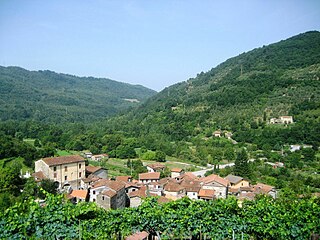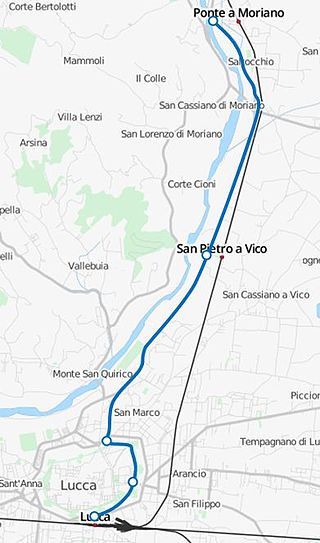
Lucca is a city and comune in Tuscany, Central Italy, on the Serchio River, in a fertile plain near the Ligurian Sea. The city has a population of about 89,000, while its province has a population of 383,957.

The province of Lucca is a province in the Tuscany region of Italy. Its capital is the city of Lucca.

Barga is a medieval town and comune of the province of Lucca in Tuscany, central Italy. It is home to around 10,000 people and is the chief town of the "Media Valle" of the Serchio River. It is one of I Borghi più belli d'Italia.

Calalzo di Cadore is a municipality of 2,400 inhabitants of the province of Belluno, in the Italian region of Veneto. The name Calalzo derives from the Latin altus callis, meaning "high place." The geographical name "di Cadore" was added by Presidential Decree on 30 June 1959.

Bagni di Lucca is a comune of Tuscany, Italy, in the Province of Lucca with a population of about 6,100. The comune has 27 named frazioni (wards).

Castelnuovo di Garfagnana is a town and comune in the province of Lucca, Toscana, central Italy. It is located at the confluence of the Serchio and the Turrite Secca rivers, close to the intersection of roads passing through the Apennine Mountains and the Apuan Alps.

Fosciandora is a comune (municipality) of 554 inhabitants in the Province of Lucca in the Italian region Tuscany, located about 70 kilometres (43 mi) northwest of Florence and about 30 kilometres (19 mi) north of Lucca.

The Archdiocese of Lucca is a Latin Church ecclesiastical territory or diocese of the Catholic Church in Italy. The diocese dates back as a diocese to at least the 4th century; it became an archdiocese in 1726. The seat of the archbishop is in Lucca, in the cathedral of S. Martino. It is not a metropolitan see, has no suffragan dioceses, and is immediately subject (exempt) to the Holy See (Papacy).

Lucca railway station serves the city and comune of Lucca, in the region of Tuscany, central Italy. Opened in 1846, it forms part of the Viareggio–Florence railway, and is also the junction for lines to Pisa and to Aulla. All of these lines are only served by regional trains.

Codiponte is a village in the municipality of Casola in Lunigiana, Tuscany, Italy. It is located in the Province of Massa and Carrara and is about 20 minutes drive from the comune of Aulla. The population is about 200.

The Battle of Garfagnana, known to the Germans as Operation Winter Storm and nicknamed the "Christmas Offensive", was a successful Axis offensive against American forces on the western sector of the Gothic Line during World War II. It took place in December 1944 in the north Tuscan Apennines, near Massa and Lucca.
The 1920 Garfagnana earthquake occurred on 7 September in Garfagnana and Lunigiana, both agricultural areas in the Italian Tuscany region. The quake hypocenter was located 14 kilometres (8.7 mi) beneath Villa Collemandina. The maximum felt intensity was rated as X (Extreme) on the Mercalli intensity scale, and 6.6 on the Richter magnitude scale. It was one of the most destructive seismic events recorded in the Apenninic region in the twentieth century. Due to good news coverage, availability of official documents on the damage and abundance of recordings from surveillance stations throughout Europe, it was regarded as a first-rate case study to improve knowledge of tectonics and macroseismic analysis.

Santa Maria delle Grazie alle Fornaci fuori Porta Cavalleggeri is a Baroque style, Roman Catholic parish and titular church located at Piazza di Santa Maria alle Fornaci, south of Vatican City and north of the San Pietro train station in the Aurelio quarter. It was made a cardinalate deaconry by Pope John Paul II on 25 May 1985, and assigned it to Cardinal Duraisamy Simon Lourdusamy, then Prefect of the Congregation for the Oriental Churches. The church became vacant on 2 June 2014 after the death of Cardinal Lourdusamy. On November 11, 2016 it was announced that Mario Zenari will succeed him.
The Garfagnina or Garfagnana is an indigenous breed of domestic goat from the mountainous Garfagnana area north of Lucca, in Tuscany in central Italy, from which it takes its name. It is raised in that area, in the comuni of Camporgiano, Careggine, Castelnuovo di Garfagnana, Fosciandora, Minucciano, Pieve Fosciana, Vergemoli and Villa Collemandina; in the comuni of Bagni di Lucca, Barga, Coreglia Antelminelli and Fabbriche di Vallico in the Media Valle del Serchio; and in the historic area of the Controneria, to the north-east of Bagni di Lucca. It may also be known as the Capra della Media Valle del Serchio or as the Capra della Controneria. It is probably the last remnant of the Apennine type of goat of Emilia, Liguria and Tuscany.

Lugliano is a small frazione (village) located in the municipality of Bagni di Lucca, in the Province of Lucca, Tuscany.

Colle di Compito is a frazione of Capannori in the province of Lucca region of Tuscany in Italy.

The walls of Lucca are a series of stone, brick, and earthwork fortifications surrounding the central city of Lucca in Tuscany, Italy. They are among the best preserved Renaissance fortifications in Europe, and at 4 kilometers and 223 meters in circumference they are the second largest intact example of a fully walled Renaissance city after Nicosia, Cyprus. The current walls of Lucca, which replaced earlier medieval and Roman fortifications, are the result of a construction campaign that started on May 7, 1504 and ended a century and a half later in 1648, with additional structural updates in the second half of the seventeenth century based on new knowledge and construction techniques. These walls play an important role in the cultural identity of the city of Lucca and its surroundings, and as a physical monument to the region's history, and Lucca's longstanding independence as a republic.

Barga-Gallicano railway station is a railway station located in the Tuscany region of central Italy serving the comunes of Barga and Gallicano. The station is situated roughly midway between the two towns from which it takes its name, in the Mologno frazione of Barga, on the east bank of the Serchio river.

The Lucca-Aulla railway also known as the Garfagnana railway is an Italian railway branch line. Running from the city of Lucca the line crosses the Garfagnana and Lunigiana regions to join the Parma–La Spezia railway in Aulla.

The Lucca–Ponte a Moriano Tramway was an urban steam tramway line that connected Lucca railway station with a renowned jute factory in Ponte a Moriano. The line was closed in 1932 and ran almost parallel to the Lucca–Aulla railway.



























